John Bengtson's Blog, page 20
November 27, 2015
Houdini – The Grim Game’s historic LA landmarks

Over the edge – with death below and imprisonment above! Harry Houdini in The Grim Game (1919), taken on the roof of the former Habour Apartments, discussed below.
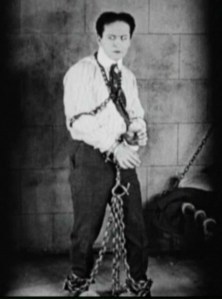 After shooting a 15-part serial The Master Mystery, world famous magician and escape artist Harry Houdini made his feature film debut in 1919 with The Grim Game, screening at the San Francisco Silent Film Festival’s special A Day of Silents held at the Castro Theater this December 5.
After shooting a 15-part serial The Master Mystery, world famous magician and escape artist Harry Houdini made his feature film debut in 1919 with The Grim Game, screening at the San Francisco Silent Film Festival’s special A Day of Silents held at the Castro Theater this December 5.
Billed as a stirring story of love, mystery, and dare-devil adventure, The Grim Game was scripted to maximize opportunities for Houdini to escape from various traps and shackles on screen.
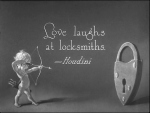 As discussed in my previous post, Buster Keaton dedicated his most famous short film Cops (1922) to Houdini, while crediting Houdini in his autobiography for giving Keaton his first name. Remarkably (could it be just a coincidence?) Keaton staged three scenes from Cops at places where Houdini had filmed previously. See Houdini – Keaton – The Grim Game – Cops.
As discussed in my previous post, Buster Keaton dedicated his most famous short film Cops (1922) to Houdini, while crediting Houdini in his autobiography for giving Keaton his first name. Remarkably (could it be just a coincidence?) Keaton staged three scenes from Cops at places where Houdini had filmed previously. See Houdini – Keaton – The Grim Game – Cops.
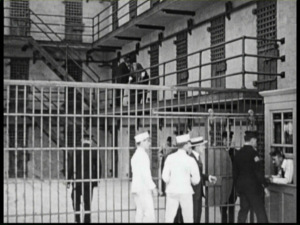 While The Grim Game is noteworthy in part for a real-life plane crash caught on film (no one was hurt, see my prior post), Houdini’s roof-top escape from a straight-jacket (above) may be the most thrilling moment in the picture. The stunt was
While The Grim Game is noteworthy in part for a real-life plane crash caught on film (no one was hurt, see my prior post), Houdini’s roof-top escape from a straight-jacket (above) may be the most thrilling moment in the picture. The stunt was 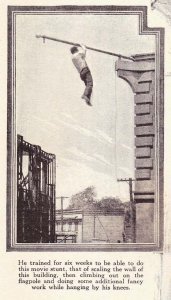 preceded by his escape from what appears to be the interior of the Los Angeles County Jail. (I’ve never seen images inside the jail,
preceded by his escape from what appears to be the interior of the Los Angeles County Jail. (I’ve never seen images inside the jail, 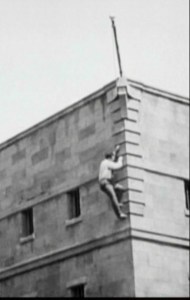 but since they filmed exterior scenes beside the jail (below), and Houdini commonly performed escapes at real jails, it’s reasonable to assume they filmed inside the jail too – a fine example of how cinema often preserves history in real life. The jail interior (upper right) also looks too elaborate to be merely a set). At left, this view (John Cox) shows Houdini hanging from a studio jail set for a different stunt.
but since they filmed exterior scenes beside the jail (below), and Houdini commonly performed escapes at real jails, it’s reasonable to assume they filmed inside the jail too – a fine example of how cinema often preserves history in real life. The jail interior (upper right) also looks too elaborate to be merely a set). At left, this view (John Cox) shows Houdini hanging from a studio jail set for a different stunt.
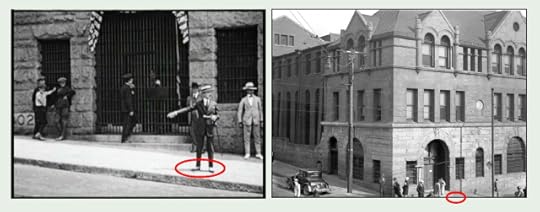
The LA County Jail as it appears in The Grim Game. Once part of the Civic Center, the jail appears during D. W. Griffith’s Intolerance (1916) and in many other early films (see link here), and stood on Temple across from the former LA County Court House where Houdini posed for publicity photos covered in my prior post. Photo from Harold Lloyd estate.
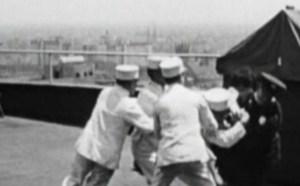 Following his jail escape, the villains next imprison Harry in a mental institution. There, breaking free and
Following his jail escape, the villains next imprison Harry in a mental institution. There, breaking free and
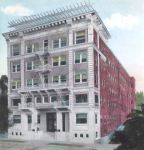
Harbour Apartments – A Visit to Old Los Angeles.
chased onto the roof, Houdini is re-captured and trussed in a straight-jacket, his ankles tied with rope. Breaking free again, Houdini falls over the edge of the roof, suspended upside down, but escapes the jacket and his captors before the rope breaks.
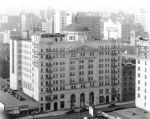 This sequence was filmed on the roof of the now lost Harbour Apartments at 612 St. Paul Street. While the image quality could be better, during the scene I immediately spotted two landmarks nearly aligned with each other, the squat
This sequence was filmed on the roof of the now lost Harbour Apartments at 612 St. Paul Street. While the image quality could be better, during the scene I immediately spotted two landmarks nearly aligned with each other, the squat 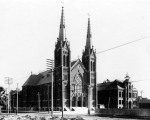 ‘chocolate drop’ dome tower of the extant Hotel Trinity and Auditorium at 851 S. Grand (left, LAPL), and the distinctive twin steeples, now lost, of St. Joseph’s Church at 1200 S. Los Angeles Street (LAPL). By reversing my orientation, and tracing a path
‘chocolate drop’ dome tower of the extant Hotel Trinity and Auditorium at 851 S. Grand (left, LAPL), and the distinctive twin steeples, now lost, of St. Joseph’s Church at 1200 S. Los Angeles Street (LAPL). By reversing my orientation, and tracing a path 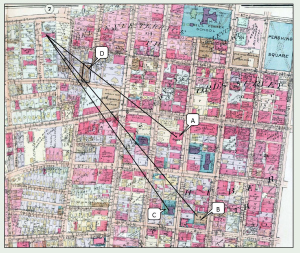 NW from the church through the
NW from the church through the 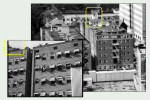 auditorium, I ended up with a narrow range of candidate apartment houses, and quickly spotted the Harbour Apartments in a panoramic photo – USC Digital Library, while also identifying other landmarks (A-D) appearing in the film.
auditorium, I ended up with a narrow range of candidate apartment houses, and quickly spotted the Harbour Apartments in a panoramic photo – USC Digital Library, while also identifying other landmarks (A-D) appearing in the film.
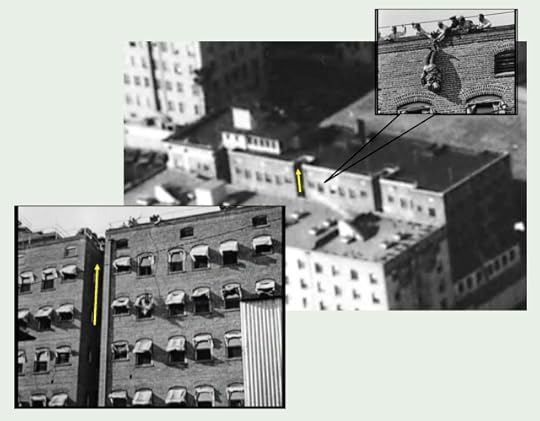
Houdini clings to life over the edge of the Harbour Apartments at 612 St. Paul Street – its southern neighbor, the Hotel Victor at 616 St. Paul, was built in 1924 long after Houdini filmed there. USC Digital Library.
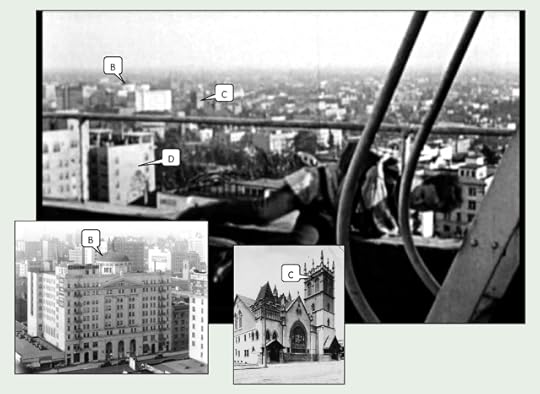
Looking SE this detailed view shows the Trinity Hotel and Auditorium (B) and the lost First Congregational Church (C) once standing at 841 S. Hope Street. LAPL. (D) marks the lost Rex Arms Apartments.

Both images show the west side of the Rex Arms (D) at 945 Orange (later Wilshire) – now lost. USC Digital Library. Charlie Chaplin and Roscoe Arbuckle filmed The Rounders there in 1914 as reported HERE.

This view shows (A) the YMCA Building, built in 1908, now lost, at 719 S. Hope, along with the Trinity (B) and First Congregational Church (C). USC Digital Library see page 11.

This final SE view reveals, to the left, the north side of the extant Hotel Stillwell that still stands on Grand Ave. across from the extant Trinity, center. The right line leads to the lost First Congregational Church. USC Digital Library.

This view looking NW from the extant Graphic Arts Building at 417 E. Pico clearly reveals the Harbour Apartments at back behind the noted landmarks (C), (B), and (D). Huntington Digital Library. The full view of this panoramic photo shows the back of the St. Joseph Church steeples to the left as well.

The face of the Harbour Apartments on St. Paul Street. Both it and the Hotel Victor next door were demolished in the 1980s. USC Digital Library.
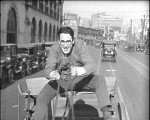 While the filming of Houdini’s straight-jacket escape was not likely publicized to avoid crowds of onlookers during the shoot, Houdini staged a similar stunt (where else to maximize publicity?) at the front offices of the Los Angeles Herald Examiner newspaper at Broadway and 11th as shown below. At left, Harold Lloyd raced past these offices during his frantic dash to the altar in Girl Shy (1924). John Cox reports in his amazing Houdini site that Harry performed his downtown straight-jacket escape below on April 5, 1923. You can read more about it at John’s story HERE.
While the filming of Houdini’s straight-jacket escape was not likely publicized to avoid crowds of onlookers during the shoot, Houdini staged a similar stunt (where else to maximize publicity?) at the front offices of the Los Angeles Herald Examiner newspaper at Broadway and 11th as shown below. At left, Harold Lloyd raced past these offices during his frantic dash to the altar in Girl Shy (1924). John Cox reports in his amazing Houdini site that Harry performed his downtown straight-jacket escape below on April 5, 1923. You can read more about it at John’s story HERE.
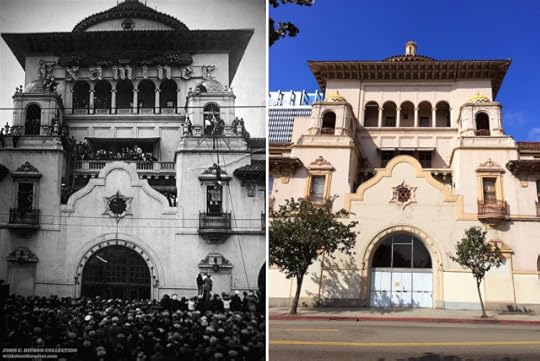
John C. Hinson Collection – John Cox WildAboutHarry.com
The film’s restorer Rick Schmidlin will introduce The Grim Game at The San Francisco Silent Film Festival’s A Day of Silents this coming December 5 at 3:00 p.m. at the Castro Theater, to be accompanied on the piano by Donald Sosin.
For a more complete account about The Grim Game, check out Mary Mallory’s post on the Daily Mirror blogsite.
Looking north up Grand at two surviving buildings visible during The Grime Game, the Trinity Hotel at left, and the Hotel Stillwell.
Filed under: Harry Houdini, Los Angeles Historic Core, The Grim Game Tagged: Harry Houdini, Herald Examiner Building, Los Angeles County Jail, Los Angeles Historic Core, Rex Arms, Silent Movie Locations, Silent Movies, Stillwell Hotel, straight-jacket escape, The Grim Game, then and now, Trinity Hotel

November 18, 2015
Houdini – Keaton – The Grim Game – Cops

During Cops (1922) Buster spies Big Joe Roberts’ dropped wallet in front of the towering Bergstrom estate, once standing at 590 N. Vermont, featured in Harry Houdini’s The Grim Game (1919).
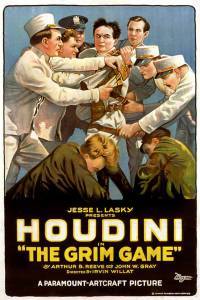 Buster Keaton writes in his autobiography that famed magician and escape artist Harry Houdini gave him his nickname after witnessing 6-month old Keaton tumble unhurt down a flight of stairs. While likely more myth than fact,* Harry and Bess Houdini did travel with Buster’s parents during their early medicine show days, and Harry’s daring stunts and escapes certainly echo in Buster’s films. Moreover, Keaton pays homage to Houdini in the opening credits of Buster’s most famous short film, Cops, the only movie in Keaton’s oeuvre to begin with an
Buster Keaton writes in his autobiography that famed magician and escape artist Harry Houdini gave him his nickname after witnessing 6-month old Keaton tumble unhurt down a flight of stairs. While likely more myth than fact,* Harry and Bess Houdini did travel with Buster’s parents during their early medicine show days, and Harry’s daring stunts and escapes certainly echo in Buster’s films. Moreover, Keaton pays homage to Houdini in the opening credits of Buster’s most famous short film, Cops, the only movie in Keaton’s oeuvre to begin with an 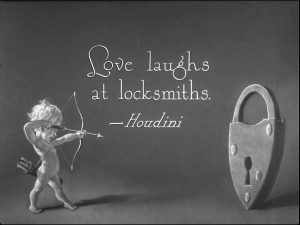 attributed quote. By remarkable coincidence (or by design?) Keaton’s Cops crossed cinematic paths with Houdini’s debut (non-serialized) feature film, The Grim Game, screening at the San Francisco Silent Film Festival’s special A Day of Silents held at the Castro Theater this December 5.
attributed quote. By remarkable coincidence (or by design?) Keaton’s Cops crossed cinematic paths with Houdini’s debut (non-serialized) feature film, The Grim Game, screening at the San Francisco Silent Film Festival’s special A Day of Silents held at the Castro Theater this December 5.

Houdini and Keaton at the same Bergstrom estate gate at the SE corner of Vermont and Clinton.
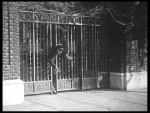 Billed as a stirring story of love, mystery, and dare-devil adventure, The Grim Game was scripted to maximize opportunities for Houdini to escape from various traps and shackles on screen. Many scenes were filmed at the home of noted architect Edwin Bergstrom, later home to theater magnate Alexander
Billed as a stirring story of love, mystery, and dare-devil adventure, The Grim Game was scripted to maximize opportunities for Houdini to escape from various traps and shackles on screen. Many scenes were filmed at the home of noted architect Edwin Bergstrom, later home to theater magnate Alexander  Pantages, before it was razed in 1956 to build a Jewish community center, now home to West Coast University. Above, Houdini filmed many scenes by the estate’s motorized sliding gate (a comic foil that also trapped Snub Pollard during the early Hal Roach Studio comedy Fresh Paint (1920) upper right). Buster staged the opening scenes from Cops, where he appropriates Big Joe Roberts’ wallet, by inter-cutting shots filmed beside the estate gate AND at the corner of Sunset and Detroit, over 4 miles away (click to enlarge blended frames at left). I describe the Sunset filming spot from Cops HERE.
Pantages, before it was razed in 1956 to build a Jewish community center, now home to West Coast University. Above, Houdini filmed many scenes by the estate’s motorized sliding gate (a comic foil that also trapped Snub Pollard during the early Hal Roach Studio comedy Fresh Paint (1920) upper right). Buster staged the opening scenes from Cops, where he appropriates Big Joe Roberts’ wallet, by inter-cutting shots filmed beside the estate gate AND at the corner of Sunset and Detroit, over 4 miles away (click to enlarge blended frames at left). I describe the Sunset filming spot from Cops HERE.
 After searching years for photos of the estate prior to its destruction, The Grim Game supplies priceless views of this lost landmark, placing it in context, while even allowing us (at right) to see inside the gate where Buster filmed.
After searching years for photos of the estate prior to its destruction, The Grim Game supplies priceless views of this lost landmark, placing it in context, while even allowing us (at right) to see inside the gate where Buster filmed.

Houdini also filmed a brief scene at the Cahuenga alley just south of Hollywood Blvd. where Buster filmed this famous stunt from Cops. The tall Palmer Building, undergoing construction behind Buster, still stands on Cosmo Street.
After documenting how Charlie Chaplin filmed The Kid (1921), Buster Keaton filmed Cops, and Harold Lloyd filmed Safety Last! (1923) all at the same East-Cahuenga alley that you can still visit in Hollywood today, I was floored to see that Harry filmed a brief scene there too. As shown above, Houdini filmed there first!

The Grim Game shows the rickety stairway that once stood at the west alley entrance on Cahuenga, also seen in these Christie comedies All Jazzed Up (1920) at left, and Hubby’s Night Out (1917) Cinematek.

Looking west towards Cahuenga, these views from Gale Henry’s Gaumont Co. short The Detectress (1919) and Keaton’s Neighbors (1920) show the back of the rickety stairway, removed before Buster returned to film Cops.
Houdini’s production received tremendous advance publicity when two airplanes crashed mid-flight while a stunt man was filmed transferring between the planes. Fortunately no one was hurt, but the accident, captured on camera, was a publicist’s dream, and Houdini himself was later touted as being the stuntman who survived the crash.
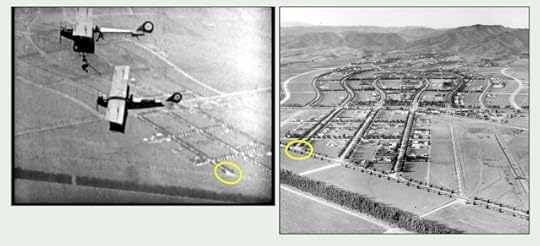
The much publicized mid-air transfer from The Grim Game. LAPL.
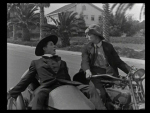 Much of Los Angeles between Hollywood and the coast was undeveloped in 1919 during the time of filming. The above shot of the mid-air transfer reveals early Beverly Hills in the background, the oval marks the corner of Wilshire and Rodeo Drive. Buster filmed this scene (left) from The Scarecrow (1920) at 618 Beverly Drive towards the middle of the aerial photo above.
Much of Los Angeles between Hollywood and the coast was undeveloped in 1919 during the time of filming. The above shot of the mid-air transfer reveals early Beverly Hills in the background, the oval marks the corner of Wilshire and Rodeo Drive. Buster filmed this scene (left) from The Scarecrow (1920) at 618 Beverly Drive towards the middle of the aerial photo above.
The Grim Game was nearly lost forever, but thanks to the restoration efforts of Rick Schmidlin, in association the New York University Libraries, as sponsored by the Turner Classic Movie Channel, we can witness once again the magic of Houdini on film this coming December 5 at 3:00 p.m. at the Castro Theater. Mr. Schmidlin will introduce the screening, to be accompanied by Donald Sosin.
Stay tuned for my upcoming post about the Los Angeles Historic Core buildings appearing in The Grim Game, including Houdini’s thrilling straight-jacket escape from the roof of the former Harbour Apartments.
*Keaton biographer Marion Meade writes contemporary newspaper accounts show actor and family friend George Pardey was credited in 1904 with giving Buster the name, and that references to Houdini as the source did not appear until years later. The Houdinis and Buster’s parents Myra and Joe were friends – Meade writes Joe treated Harry as a younger brother, affectionately calling him “Boots.”
For a more complete account about The Grim Game, check out Mary Mallory’s post on the Daily Mirror blogsite.
590 N. Vermont, former site of the Bergstrom estate.
Filed under: Buster Keaton, Cops Tagged: Alexander Pantages, Buster Keaton, Edwin Bergstrom, Harry Houdini, Keaton Locations, Los Angeles Historic Core, Silent Comedians, Silent Comedies, Silent Movie Locations, Silent Movies, The Grim Game, then and now

October 29, 2015
Keaton – Langdon – Lloyd on Larchmont – Ebell Club Author Talk
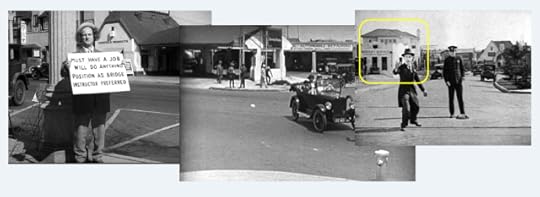
Larry Fine in Hoi Polloi (1935), Harold Lloyd and family in Hot Water (1924), and Harry Langdon in His Marriage Wow (1925), a panorama at 1st and Larchmont. The home at back still stands, see directly below.
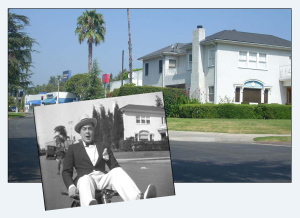
Poodles Hanneford in Better Behave (1928) at 1st and Gower.
Developed along a street car line (always ripe for slapstick antics), Larchmont Boulevard has been a popular movie location for nearly 100 years. Harold Lloyd filmed there as early as 1917. During my luncheon talk at the Ebell Club on Monday, November 16, I will provide a multi-media tour of how the great silent comedians filmed their classic movies on the streets of Hollywood, focusing both on Larchmont where Buster Keaton, Harry Langdon, and even the Three Stooges once filmed, and Fremont Place, where Charlie Chaplin and others filmed just steps from the Ebell Club itself.
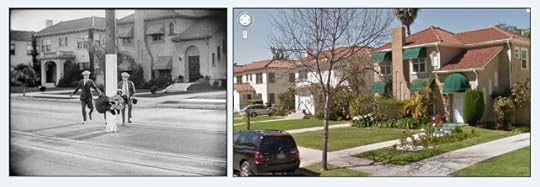
Harry Langdon in Saturday Afternoon (1926) at 221 S. Larchmont. (C) Google.
The “yellow car” Los Angeles Railway Line No. 3 ran from Melrose at Larchmont to downtown. Since Larchmont was quite wide, the trolley power line poles were perilously installed down the middle of the street, a tempting target for comedians. Above, Harry Langdon survives crashing sideways into one of these poles.
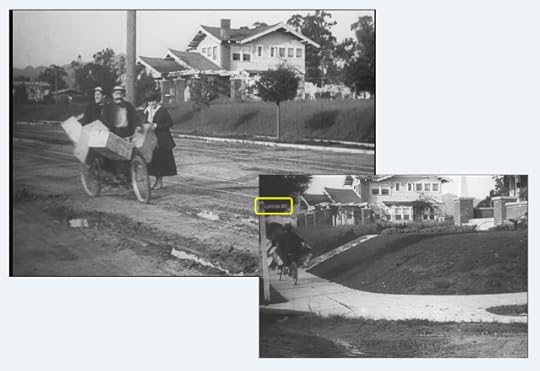
Click to enlarge – Harold Lloyd and Snub Pollard in Lonesome Luke Messenger (1917).
The Larchmont commercial block between Beverly and 1st was an attractive setting for early movies. Yet, as shown above, Harold Lloyd filmed long before commercial development began in 1921. This scene from February or March of 1917 shows the homes at the NE corner of Clinton and Larchmont (see street sign), a block south of Melrose. The corner today is unrecognizable.

From The Red Kimona (1925), looking east from the porch of 53 Fremont Place, still standing, towards the Aronson mansion at 31 Fremont Place, now lost, once adjacent to the Ebell. The upper image looks west along 8th Street from the Ebell towards the former Aronson home. Fremont Place blogspot.
Above, one of several early movies filmed at Fremont Place, adjacent to the Ebell Club on Wilshire. Several grand mansions, now lost, are preserved in early cinema. Below, Harold returned to Larchmont nine years later to film For Heaven’s Sake on the main commercial block. Buster Keaton and Harry Langdon filmed here as well.

Harold herds a group of drunks onto a double-decker bus in For Heaven’s Sake (1926) at 113 N. Larchmont.
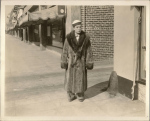
Buster at 148 N. Larchmont
If you live in the Los Angeles area, I hope you’ll consider attending my talk and book-signing at the Ebell of Los Angeles this coming Monday November 16.
Ebell of Los Angeles: 743 South Lucerne Boulevard, Los Angeles 90005 323-931-1277.
HAROLD LLOYD images and the names of Mr. Lloyd’s films are all trademarks and/or service marks of Harold Lloyd Entertainment Inc. Images and movie frame images reproduced courtesy of The Harold Lloyd Trust and Harold Lloyd Entertainment Inc.
A prior post about Harry Langdon on Larchmont
Bobby Cress’s Dear Old Hollywood Blogspot showing how Larchmont appeared in Bob Hope’s 1967 movie Eight on the Lam.
Filed under: Harold Lloyd, Harry Langdon Tagged: Buster Keaton, Charlie Chaplin, Ebell Club, Ebell of Los Angeles, For Heaven's Sake, Fremont Place, Harold Lloyd, Harry Langdon, His Marriage Wow, Hot Water, Larchmont, Larchmont Village, Poodles Hanneford, Saturday Afternoon, Silent Comedians, Silent Comedies, Silent Movie Locations, Silent Movies, The Red Kimona, then and now

October 6, 2015
Ginger, Buster, and Groucho, Lon Chaney and Loretta Young, all at the Jewett Estate
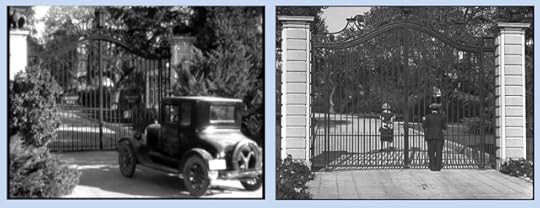
Matching views of the Jewett Estate gate in Finishing School and Cops
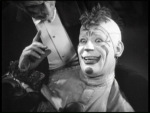
The great Lon Chaney
As reported in a recent post, Buster Keaton in Cops, Harpo and Groucho Marx in Duck Soup, and the 1947 murder noir classic Born to Kill, all filmed scenes at the Jewett Estate in Pasadena. We can now add Lon Chaney (vicariously) and 14 year old Loretta Young in Laugh, Clown, Laugh (1928 ), and Ginger Rogers in Finishing School (1934) to the mix. As more classic films become available for study, the long list of productions staged at the Jewett Estate will continue to grow.
In Laugh, Clown, Laugh, Loretta Young plays an abandoned child found by clown Lon Chaney, who raises her in the circus. Early in the film, Loretta climbs a fence into the Jewett Estate looking to pick a rose, where she meets a wealthy count, played by Nils Asther, who is instantly smitten.

Laugh, Clown, Laugh – Nils leads Loretta north from the Jewett Estate Lily Pool, matching this view of Groucho, Louis Calhern, and Margaret Dumont in Duck Soup (1933).
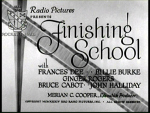 The same garden view, looking south from the Jewett mansion towards the formal Lily Pool, appears during this calisthenic class scene from Finishing School (below), where the estate portrays Crockett Hall, an exclusive boarding school.
The same garden view, looking south from the Jewett mansion towards the formal Lily Pool, appears during this calisthenic class scene from Finishing School (below), where the estate portrays Crockett Hall, an exclusive boarding school.

Morning exercise class from Finishing School at right.
During this closeup of Ginger Rogers mocking her dance instructor, we see the same portion of a garden balustrade appearing with Groucho in Duck Soup.

Ginger and Groucho
Finishing School also provides a “behind the scenes” view of the long driveway leading north to the mansion from the south facing gate Buster Keaton used in Cops (1922), and in the William Haines – Joan Crawford comedy-romance Spring Fever (1927).

The upper left and lower right images from Finishing School suggest the full length of the driveway, which leads north from the gate on Arden Road appearing in Cops, upper right, and in Spring Fever, lower left.
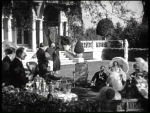
Looking towards the south face of the estate from Laugh, Clown, Laugh
The lavish Jewett estate, located at 1145 Arden Road in Pasadena, has portrayed cinematic wealth and grandeur for nearly a century. Completed in 1915, the Palladian-style villa was once set amidst vast gardens adorned with Italian sculptures and fountains. Below are matching details of the same figure appearing in Laugh, Clown, Laugh and in Duck Soup.

Duck Soup – left, and Laugh, Clown, Laugh
For more complete information about of the Jewett Estate, and many more photos, please see my previous post HERE.
Filed under: Buster Keaton, Cops, Duck Soup Tagged: Arden Road, Buster Keaton, Cops, Duck Soup, Finishing School, Ginger Rogers, Groucho Marx, Harpo Marx, Jewett Estate, Joan Crawford, Laugh Clown Laugh, Lon Chaney, Silent Comedians, Silent Comedies, Silent Movie Locations, Silent Movies, Spring Fever, then and now, William Haines

September 12, 2015
San Francisco’s Silent Echoes – Presidio Officers’ Club Talk

Buster Keaton in The Navigator (1924) beside the former A.D. Moore mansion on Divisadero at Pacific.
Buster Keaton in Pacific Heights? Charlie Chaplin at Fisherman’s Wharf? Harold Lloyd at UC Berkeley? The great silent comedians did not limit themselves to filming in Hollywood, as I will discuss during my San Francisco’s Silent Echoes presentation this Thursday, September 17, 7:00 p.m. at the Presidio Officers’ Club. Presented in association with The San Francisco Silent Film Festival, the event is free, although advance registration is required. Of particular interest to history buffs, my talk will cover both lost local landmarks, such as Oakland’s Idora Park (1903-1929) featured in the Mabel Normand/Roscoe Arbuckle Keystone comedy Mabel’s Willful Way (1915), and settings that remain remarkably unchanged more than 90 years later.

Mabel Normand and Roscoe Arbuckle feed the bears at the former Idora Park in Oakland.

Douglas Fairbanks in front of the Ferry Building (standing in for New York) in When The Clouds Roll By (1919).
This link below will download a PDF tour of where Buster Keaton filmed scenes in San Francisco.
San Francisco’s Silent Echoes Buster Keaton
Filed under: Uncategorized Tagged: Buster Keaton, Douglas Fairbanks, Mabel Normand, Mabel's Willful Way, Roscoe Arbuckle, San Francisco then and now, Silent Comedians, Silent Movie Locations, The Navigator, then and now, When the Clouds Roll By

August 26, 2015
New Chaplin Discovery – Cinecon Talk and Guided Tour

Chaplin filming The Pilgrim in Newhall (now part of Santa Clarita). SCVhistory.com.
While preparing my upcoming talk for Cinecon 51 I just realized that Chaplin filmed this rustic church scene from The Pilgrim (1923) in Newhall, near where friend Douglas Fairbanks filmed much of Wild and Woolly in 1917, beside the original Presbyterian Church, built in 1891, that once stood at the west end of Market Street at Newhall Avenue. You can read about the connections between Chaplin’s The Pilgrim and Frank Sinatra’s assassination/kidnap drama Suddenly (1954) in my prior post, and download a written tour at the end of this post.
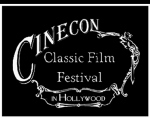
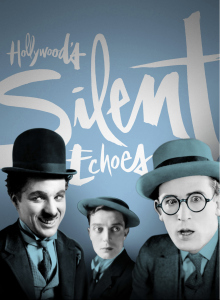 I will discuss Wild and Woolly, and Harold Lloyd’s masterpiece The Kid Brother (1927), two wonderful films highlighted at the 2015 Cinecon Classic Film Festival, as part of the “Hollywood’s Silent Echoes” presentation I will be giving Labor Day Monday, September 7, 2017, at 11:05 a.m. at the Egyptian Theater, 6712 Hollywood Boulevard. Entirely new, my talk will be filled with many fun surprises about the great silent comedians, and the historic elements captured in their films.
I will discuss Wild and Woolly, and Harold Lloyd’s masterpiece The Kid Brother (1927), two wonderful films highlighted at the 2015 Cinecon Classic Film Festival, as part of the “Hollywood’s Silent Echoes” presentation I will be giving Labor Day Monday, September 7, 2017, at 11:05 a.m. at the Egyptian Theater, 6712 Hollywood Boulevard. Entirely new, my talk will be filled with many fun surprises about the great silent comedians, and the historic elements captured in their films.
Following my talk and book signing I will again lead a walking tour during the lunch break along Cahuenga Boulevard where Chaplin, Keaton, and Lloyd filmed so frequently.

Click to enlarge – the two camera angles are almost a perfect match. The church was built in 1891 and replaced with a modern stucco structure in 1923, the same year Chaplin filmed The Pilgrim. SCVhistory.com.
The link below is an updated written tour to over 50 Hollywood filming locations and historic sites associated with Charlie Chaplin, Buster Keaton, Harold Lloyd, Douglas Fairbanks, Mary Pickford, Stan Laurel, and Harry Langdon. This latest edition includes many new discoveries not found in my books or previously posted tours.
Hollywood’s Silent Echoes Tour – Cinecon 2015 – John Bengtson
For those who live in LA, even if you have plans for an afternoon BBQ, I hope you’ll consider spending Labor Day morning at the Egyptian Theater discovering some fun new insights about early Hollywood.
All images from Chaplin films made from 1918 onwards, copyright © Roy Export Company Establishment. CHARLES CHAPLIN, CHAPLIN, and the LITTLE TRAMP, photographs from and the names of Mr. Chaplin’s films are trademarks and/or service marks of Bubbles Incorporated SA and/or Roy Export Company Establishment. Used with permission.
Filed under: Charlie Chaplin, The Pilgrim Tagged: Chaplin Locations, Chaplin Tour, Charlie Chaplin, Hollywood Tour, Silent Comedians, Silent Comedies, Silent Movie Locations, then and now

August 7, 2015
Chaplin, Sinatra, The Pilgrim and Noir
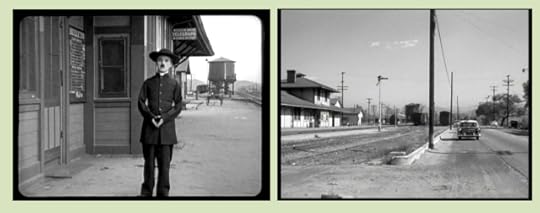
Charlie beside the Saugus station in The Pilgrim and as it appears in Suddenly. The unusual movie title refers to the fictional town “Suddenly” in which that movie takes place.
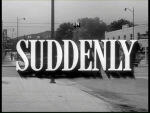 Classic movies filmed on location provide historic views of the past. Moreover, later films shot at a popular location also provide fresh perspectives of earlier movies filmed at the same spot. A case in point is the Saugus train station appearing both in Charlie Chaplin’s The Pilgrim (1923), and later in the 1954 Frank Sinatra hostage-sniper drama Suddenly. Although the station still exists (relocated to a nearby park a few miles away), it was difficult finding vintage photos of the station in its original setting at the time I was writing about The Pilgrim for my Chaplin book. Thus, seeing the station documented so vividly in the Sinatra film was a revelation for visualizing how Charlie had used the same setting thirty years before Frank.
Classic movies filmed on location provide historic views of the past. Moreover, later films shot at a popular location also provide fresh perspectives of earlier movies filmed at the same spot. A case in point is the Saugus train station appearing both in Charlie Chaplin’s The Pilgrim (1923), and later in the 1954 Frank Sinatra hostage-sniper drama Suddenly. Although the station still exists (relocated to a nearby park a few miles away), it was difficult finding vintage photos of the station in its original setting at the time I was writing about The Pilgrim for my Chaplin book. Thus, seeing the station documented so vividly in the Sinatra film was a revelation for visualizing how Charlie had used the same setting thirty years before Frank.
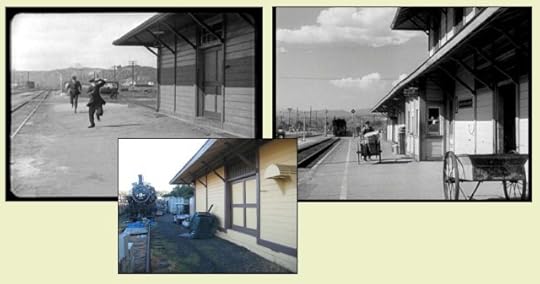
Charlie (left) runs beside the Saugus station, more fully revealed in the Suddenly frame, and as it appears today at its new location. Color images by E. J. Stephens.
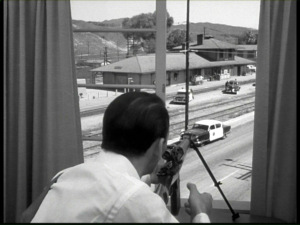
Sniper Sinatra takes aim
The Southern Pacific Saugus Train Station was originally located on the east side of San Fernando Road, just south of Drayton Street in what is now called Santa Clarita, a few miles east of the Six Flags Magic Mountain amusement park, about 40 miles from downtown Los Angeles. Henry Newhall named the station after the Massachusetts town “Saugus” where his father was born. The station was dedicated in by California Governor Washington Bartlett and Southern Pacific president David D. Colton. I write in my book that the dedication took place September 1, 1887, while historian John Sweetser posts at the Santa Clarita Valley history site SVCHistory.com that the opening was reported in the June 22, 1888 Los Angeles Daily Herald.

The station as it appears in Suddenly and at its new home. E. J. Stephens.
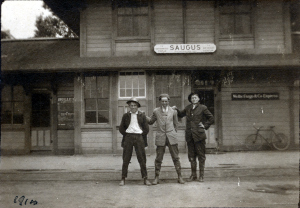
SCVHistory.com, collection of Alan Pollack.
The depot was saved from demolition in 1980 when it was relocated three miles south to the Heritage Junction Historic Park, operated by the Santa Clarita Valley Historical Society, at 24107 San Fernando Road in Newhall. The park sits adjacent to the William S. Hart Regional Park, containing the former ranch and mansion of the famed silent film cowboy and movie director. The Saugus station (at its new setting) appeared more recently in The Grifters (1989) starring Angelica Huston, Annette Bening, and John Cusack. The station’s placement in its new setting now makes the “front” of the station less accessible than the back.

Arriving trains – 1923 and 1954
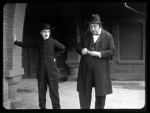 As I explain in my book, Chaplin continued filming The Pilgrim in Pasadena, using both the Raymond Station (left), and the Raymond depot – part of the Raymond Hotel (right), both lost to history. You can
As I explain in my book, Chaplin continued filming The Pilgrim in Pasadena, using both the Raymond Station (left), and the Raymond depot – part of the Raymond Hotel (right), both lost to history. You can 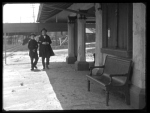 read more about the filming of Suddenly in Saugus in Robby Cress’s entertaining and remarkably broad-ranged movie and television location blog Dear Old Hollywood.
read more about the filming of Suddenly in Saugus in Robby Cress’s entertaining and remarkably broad-ranged movie and television location blog Dear Old Hollywood.
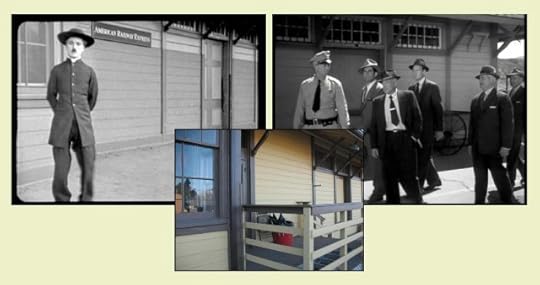
Charlie cools his heels near where Sterling Hayden converses with a group of Secret Service agents.
My thanks to E. J. Stephens, noted Hollywood historian, author, lecturer and tour guide, and co-host, with Bill West, of the SCVTV movie series “SCV In the Movies,” for providing the color photos. You can find E. J.’s books about early Warner Bros, early Paramount Studios, and Griffith Park, at this link.
All images from Chaplin films made from 1918 onwards, copyright © Roy Export Company Establishment. CHARLES CHAPLIN, CHAPLIN, and the LITTLE TRAMP, photographs from and the names of Mr. Chaplin’s films are trademarks and/or service marks of Bubbles Incorporated SA and/or Roy Export Company Establishment. Used with permission. Suddenly (C) 1954 Libra Productions, Inc.
The Saugus station at its new home, 24107 San Fernando Road in Newhall.
Filed under: Charlie Chaplin, Film Noir Tagged: Chaplin Locations, Chaplin Tour, Charlie Chaplin, film noir, Frank Sinatra, Heritage Junction Historic Park, Newhall, Saugus, Saugus train station, Silent Comedians, Silent Movie Locations, Sterling Hayden, Suddenly, then and now

July 5, 2015
Groucho, Buster, and Noir – at the Pasadena Jewett Estate
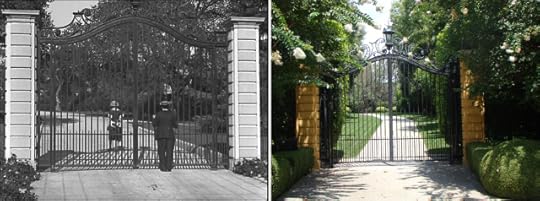
Buster Keaton beside the Jewett estate gate in Cops (1922).
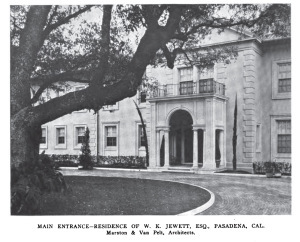 From Buster Keaton and the Marx Brothers, to noir classics and the 1980s soap opera Dynasty, the lavish Jewett estate located at 1145 Arden Road in Pasadena has portrayed cinematic wealth and grandeur for nearly a century. Designed by architects Sylvanus Marston & Garrett Van Pelt, and completed in 1915, the Palladian-style villa was once set amidst vast gardens adorned with Italian sculptures and fountains, and remains accessed from a gated entry along a 100-foot-long driveway.
From Buster Keaton and the Marx Brothers, to noir classics and the 1980s soap opera Dynasty, the lavish Jewett estate located at 1145 Arden Road in Pasadena has portrayed cinematic wealth and grandeur for nearly a century. Designed by architects Sylvanus Marston & Garrett Van Pelt, and completed in 1915, the Palladian-style villa was once set amidst vast gardens adorned with Italian sculptures and fountains, and remains accessed from a gated entry along a 100-foot-long driveway.

Matching views of the main entrance and driveway turnaround in the twisted film noir murder classic Born to Kill (1947), starring Claire Trevor and Lawrence Tierney (top), and in the William Haines – Joan Crawford 1927 comedy-romance Spring Fever. Notice the tree stands towards the south edge of the turnaround.
The estate’s imposing formal gate, appearing during the opening scenes of Buster Keaton’s most famous short film Cops (see above and below), was one of the first location discoveries I ever made. The profound thrill of visiting that spot in person, and appreciating, beyond the narrow view captured on film, the full 360 degree environment Keaton and his crew experienced when shooting the scene, inspired me to delve more deeply into Buster’s work, and ultimately lead to my first book.

The gate on Arden Road appearing in Spring Fever (left) compared with Buster in Cops. Shown below, visual clues from Spring Fever help identify scenes from the Marx Brothers in Duck Soup.
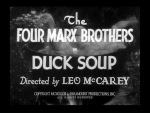 I first read the Marx Brothers’ political satire Duck Soup (1933) was filmed at the estate in Leon Smith’s film location book Hollywood Goes On Location (1993). The estate lost many formal gardens north of the house when the property was
I first read the Marx Brothers’ political satire Duck Soup (1933) was filmed at the estate in Leon Smith’s film location book Hollywood Goes On Location (1993). The estate lost many formal gardens north of the house when the property was 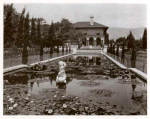 subdivided (including its original 1201 address), but two popular filming spots appearing with Groucho, the long formal lily pond south of the home (see view, left, looking north towards the home), and the driveway turnaround beside the home entrance, anchored by a massive oak tree, shown above, remain prominent features of the estate.
subdivided (including its original 1201 address), but two popular filming spots appearing with Groucho, the long formal lily pond south of the home (see view, left, looking north towards the home), and the driveway turnaround beside the home entrance, anchored by a massive oak tree, shown above, remain prominent features of the estate.

From Duck Soup, Groucho and Margaret Dumont, looking south along the formal Lily Pool.

These detailed views reveal the elaborate circular arbor that stood behind Groucho at the south end of the Lily Pool. I am unable to determine whether the arbor remains today.

A modern swimming pool has been installed immediately south of the home where this carved circular lawn ornament once stood. The view left looks north towards the home, the views to the right, Duck Soup above, and Spring Fever below, look south down the extant Lily Pool.

From Duck Soup, left, the assembled guests stand at attention awaiting the entrance of Freedonia President Rufus T. Firefly (Groucho), filmed looking north along the formal row of trees that once stood north of the home. The images from Spring Fever, at right, show a similar view (top), and an opposing view looking south from the north garden towards the north end of the home. Note the Cupid fountain in the lower right.

Groucho surprises the awaiting guests by making his entrance from the side. The fountain behind him appears identical to the fountain in the Spring Fever frame (left). The estate had several rectangular formal gardens standing north of the home, so Groucho could have filmed elsewhere beside a similar fountain. Otherwise, Groucho likely followed the arrow pointing east in each image. The original gardens north of the home were lost when the estate was subdivided.
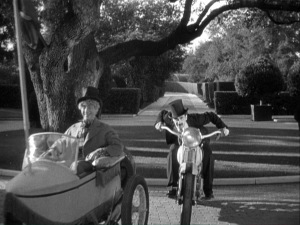 During one running gag in Duck Soup Groucho is left behind each time Harpo picks him up with a motorcycle sidecar. For this version of the joke Groucho attempts to outsmart Harpo by sitting on the motorbike instead,
During one running gag in Duck Soup Groucho is left behind each time Harpo picks him up with a motorcycle sidecar. For this version of the joke Groucho attempts to outsmart Harpo by sitting on the motorbike instead, 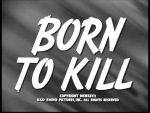 but even then Harpo prevails, as this time the sidecar drives away, once again leaving Groucho stranded. We know from movies such as Born to Kill and Spring Fever (and confirmed by modern aerial views) that the massive oak tree standing in the driveway turnaround is
but even then Harpo prevails, as this time the sidecar drives away, once again leaving Groucho stranded. We know from movies such as Born to Kill and Spring Fever (and confirmed by modern aerial views) that the massive oak tree standing in the driveway turnaround is  situated off center, near the south end of the turnaround. Thus, this view of Harpo fleeing Groucho (left) was filmed at the turnaround looking north. This landmark tree still guards the home, and is visible from the front gate (see below).
situated off center, near the south end of the turnaround. Thus, this view of Harpo fleeing Groucho (left) was filmed at the turnaround looking north. This landmark tree still guards the home, and is visible from the front gate (see below).

Matching views looking north towards the driveway turnaround oak tree still standing today.

As Groucho watches Harpo drive away, looking south along the driveway from the turnaround behind Groucho, a gate tower (oval) appears in the distance, matching the gate tower from Cops (inset).
According to the Los Angeles Times, the original owner William Kennon Jewett was heir to a railroad fortune in Ohio and struck it rich as head of a gold mine in Colorado. In 2005 the Times reported the 13,498-square-foot house, with nine bedrooms, seven bathrooms, nine fireplaces, and an elevator, was listed for sale at $14.5 million. The estate appears in many early films, including Ann Harding’s Paris Bound (1929) and the sole Amos ‘n Andy feature film Check and Double Check (1930). As reported in the LA Times, the Mae West feature Goin’ To Town (1935), the long-running prime time soap opera Dynasty, and recent televisions shows such as CSI: Miami, and major films such as Gods and Monsters (1998) and Terms of Endearment (1983), were also filmed at the estate.

Click to enlarge – looking south at the Jewett estate today, with Cops at top, Duck Soup middle left and right, Spring Fever lower left, and Born to Kill lower right. All views are oriented properly to the aerial photo, except for the Cops gate which was filmed from the street looking towards the home. The north garden in the Spring Fever frame has been lost to subdivision at the bottom edge. (C) 2015 Microsoft Corporation Pictometry Bird’s Eye (C) 2015 Pictometry International Corp.
The Jewett estate was one of thousands of stately homes, churches, and country clubs, ranging from Burlingame to San Diego, listed in the 1920s-1950s with the Assistance League Film Location Bureau, a charitable organization founded by Mrs. Hancock Banning that rented lavish locations for use by movie studios. The participating owners allowed filming on their property in exchange for rental fees paid by the studios, that were in turn donated to the Assistance League’s charitable causes. The win-win arrangement allowed the wealthy to support charity without spending a dime, while saving the studios the tremendous cost of building sets in lieu of filming at true locations. Mrs. Lee Fay Turner ran the bureau from at least 1929 to 1951. While further details about this group’s history await discovery, apparently the bureau assisted, for example, with renting locations used for the 1937 production of A Star is Born.

While Buster would later work with the Marx Brothers as a gag writer at M-G-M, I wonder if they ever realized they had both once filmed at the Jewett Estate.
Vintage photos Architectural Record Vol. 52, page 34, 1922, and Through the Ages Magazine, Vol. 4, No. 3 July 1926, pp. 22-29.
Filed under: Buster Keaton, Duck Soup, Film Noir Tagged: Arden Road, Born to Kill, Buster Keaton, Cops, Duck Soup, Dynasty, film noir, Groucho Marx, Harpo Marx, Jewett Estate, Marx Brothers, Silent Comedians, Silent Comedies, Silent Movie Locations, Silent Movies, Spring Fever, then and now

June 7, 2015
Charlie Chaplin City Lights Tour – Author Presentation
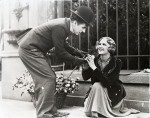 As part of the Los Angeles Conservancy Last Remaining Seats film series, on June 13, 2015 I will be introducing Charlie Chaplin’s masterpiece City Lights at the spectacular Los Angeles Theater where the film premiered January 30, 1931. Although the show is now sold out, I have prepared the attached self-guided written tour (below) to the many downtown and Wilshire Boulevard film locations appearing during the film that I will cover as part of my presentation.
As part of the Los Angeles Conservancy Last Remaining Seats film series, on June 13, 2015 I will be introducing Charlie Chaplin’s masterpiece City Lights at the spectacular Los Angeles Theater where the film premiered January 30, 1931. Although the show is now sold out, I have prepared the attached self-guided written tour (below) to the many downtown and Wilshire Boulevard film locations appearing during the film that I will cover as part of my presentation.
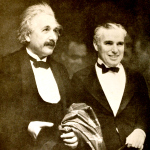
Albert Einstein and Chaplin at the premiere
The tour starts at the Los Angeles Theater at 615 S. Broadway, and covers many locations within steps of the theater before heading west along Wilshire Boulevard. Unlike the gritty locations appearing during The Kid (1921), Chaplin sought out modern and urbane settings for City Lights. Yet another example of how the varied streets of Los Angeles were used to set the right character and tone for the movies. After the screening I will be signing copies of my Chaplin book Silent Traces.
Charlie Chaplin City Lights Film Location Tour – John Bengtson
You can read more new discoveries about City Lights and the Los Angeles Theater HERE.
All images from Chaplin films made from 1918 onwards, copyright © Roy Export Company Establishment. CHARLES CHAPLIN, CHAPLIN, and the LITTLE TRAMP, photographs from and the names of Mr. Chaplin’s films are trademarks and/or service marks of Bubbles Incorporated SA and/or Roy Export Company Establishment. Used with permission.
Filed under: Chaplin Tour, Charlie Chaplin, City Lights, Los Angeles Historic Core Tagged: Chaplin Locations, Chaplin Tour, Charlie Chaplin, Los Angeles Historic Core, Silent Comedians, Silent Comedies, Silent Movie Locations, Silent Movies, then and now

May 28, 2015
Harold Lloyd’s Speedy – Five Fun Facts
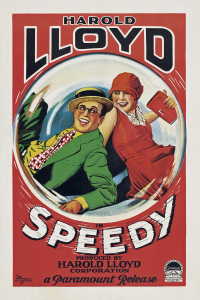 This Saturday morning, May 30, Harold Lloyd’s granddaughter Suzanne Lloyd and I will be introducing Lloyd’s final silent comedy Speedy (1928) at the Castro Theater as part of the San Francisco Silent Film Festival’s 20th anniversary program. Live musical accompaniment will be provided by Rodney Sauer’s Mont Alto Motion Picture Orchestra. Here are five fun facts about the movie.
This Saturday morning, May 30, Harold Lloyd’s granddaughter Suzanne Lloyd and I will be introducing Lloyd’s final silent comedy Speedy (1928) at the Castro Theater as part of the San Francisco Silent Film Festival’s 20th anniversary program. Live musical accompaniment will be provided by Rodney Sauer’s Mont Alto Motion Picture Orchestra. Here are five fun facts about the movie.

While most “New York” based films contain only a few stock footage establishing shots, Lloyd filmed ALL OVER – from Hamilton Heights north, to the tip of Bowling Green south, as well as in the Bronx, Brooklyn, and Coney Island.

Lou Gehrig has a cameo DURING Babe Ruth’s cameo. You can read more about Gehrig’s appearance HERE.

Throughout the film Speedy cuts back and forth between scenes shot in New York and Los Angeles. This view looks south down Witmer in Los Angeles towards the Mayfair Hotel. This hotel appears in the 1950 film noir Edge of Doom and in the television series The Office. (C) 2011 Google.

Buster Keaton (far left) and Al St. John rode the same Witching Waves ride at Luna Park during their Roscoe Arbuckle short comedy Coney Island (1917) that Harold and Ann Christy rode ten years later filming Speedy.

Lloyd built a huge New York backlot (box) near Westwood Village (at back). The lot stood not far from the Westwood Village Memorial Park (dark vegetation left of center), where many notables, including Marilyn Monroe, are buried. A middle school and a large Mormon temple were built on the backlot site.
I’ve posted many other stories about Speedy (see the list HERE), and cover it thoroughly in my Harold Lloyd film locations book Silent Visions. Here’s also a link to an online article I prepared for the Museum of the Moving Image in New York when I spoke there in 2011. I’ll be available all this weekend to sign books at the festival.
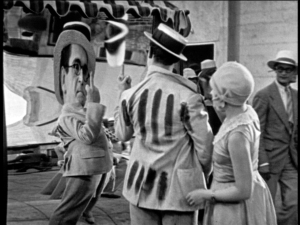 In closing, here’s something you don’t see everyday – Harold extending the “digitus impudicus.”
In closing, here’s something you don’t see everyday – Harold extending the “digitus impudicus.”
Filed under: Harold Lloyd, New York, Speedy Tagged: Harold Lloyd, Manhattan, New York, Silent Comedians, Silent Comedies, Silent Movie Locations, Speedy, then and now




